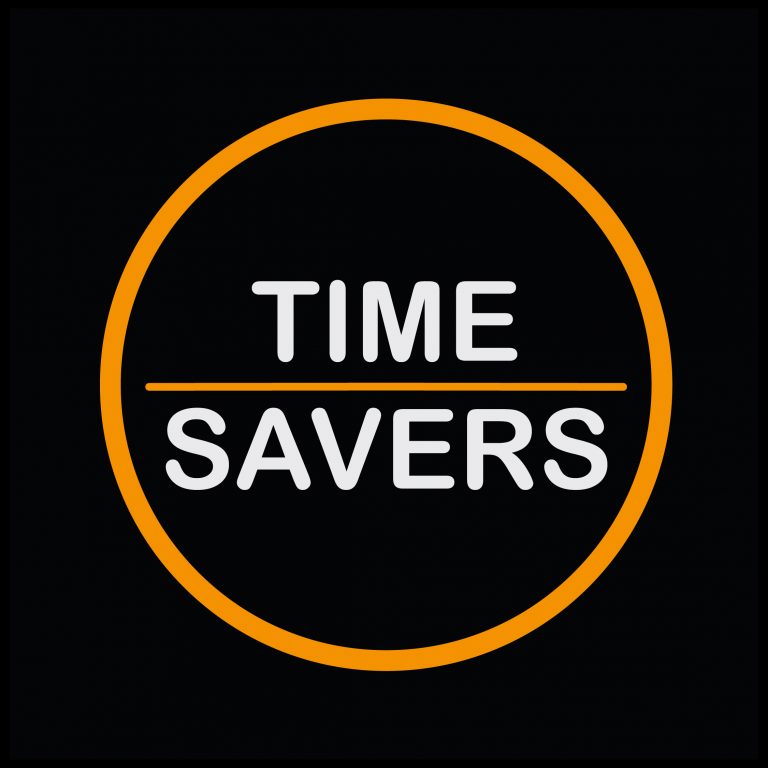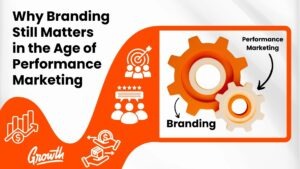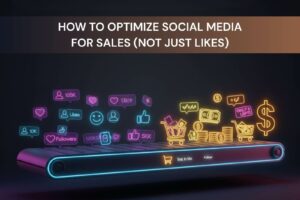You’re staring at your ad dashboard, trying to figure out if a 2x ROAS is crushing it or if you’re basically lighting money on fire.
Every marketing guru has a different answer. “4x is the minimum!” “Anything above 2x is profitable!” “It depends on your margins!”
These can all be true, but here’s what nobody tells you…
Asking “what’s a good ROAS?” is like asking “what’s a good salary?” It completely depends on your business, your industry, and what you’re trying to accomplish.
In 2025, ROAS has gotten more complicated. Customer journeys are longer, attribution is messier, and your competitors are throwing serious money at the same audiences you’re targeting.
Let’s cut through the generic advice and figure out what ROAS means for your business in 2025 and why it’s important to understand this metric.
What ROAS Actually Measures (And What It Doesn’t)
ROAS is simple math: Revenue ÷ Ad Spend. Spend $1,000, make $4,000, you’ve got 4x ROAS.
But here’s where most people get confused…ROAS doesn’t tell you if you’re profitable. ROAS measures top-line revenue, not profit.
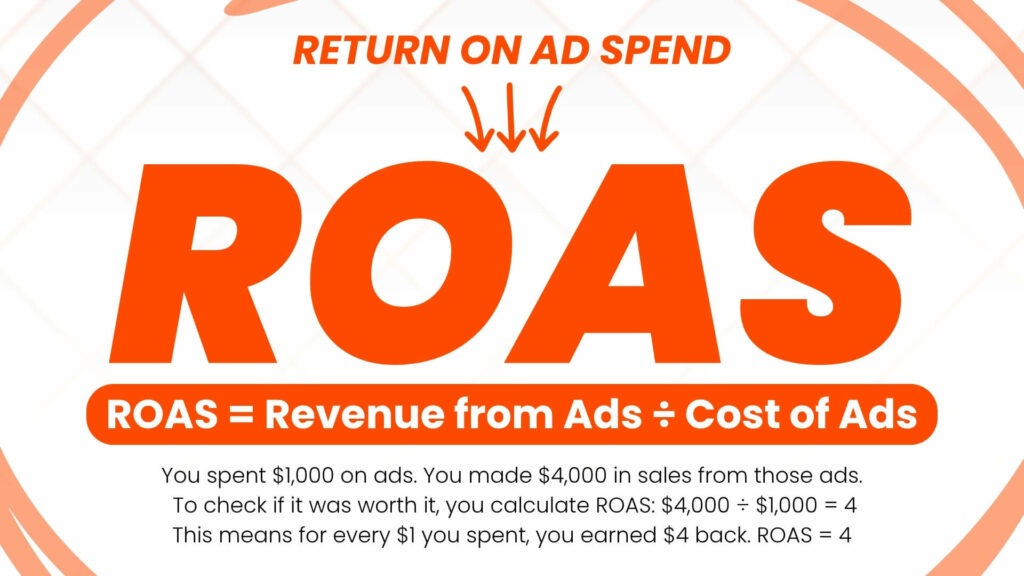
ROAS also doesn’t capture the full customer journey. Someone might see your Facebook ad, research you on Google, read reviews, then buy three weeks later through a direct search. Your Facebook campaign gets zero credit for that sale, even though it started the entire process.
And in 2025, this attribution mess has gotten worse. iOS updates killed Facebook’s tracking, third-party cookies are disappearing, and customers bounce between devices more than ever. Your “real” ROAS is probably higher than what your dashboard shows, but good luck proving it.
ROAS is a useful metric, but it’s not the whole story. It’s one piece of data in a bigger profitability puzzle.
So, What’s Considered a Good ROAS in 2025?
Most marketing articles will give you some generic chart like “3x is good, 5x is great!” But that’s like saying “a good temperature is 70 degrees” without mentioning if you’re talking about your living room or your oven.
Your “good” ROAS depends entirely on your profit margins and business model.
If you’re selling $20 products with $2 profit margins (looking at you, dropshippers), you need 10x+ ROAS just to stay afloat. If you’re selling $5,000 consulting packages with 80% margins, 2x ROAS might make you rich.
Here’s how to think about it:
- 2x ROAS: You’re probably breaking even or losing money unless you have incredible margins or strong backend sales. This might work for lead generation or if you’re optimizing for lifetime value.
- 3x-4x ROAS: The sweet spot for most e-commerce businesses with healthy margins (30-50%). This usually means you’re profitable and can scale.
- 5x+ ROAS: Either you’ve cracked the code with amazing creative and targeting, or you’re selling high-margin products. Celebrate when you have it but don’t expect this consistently.
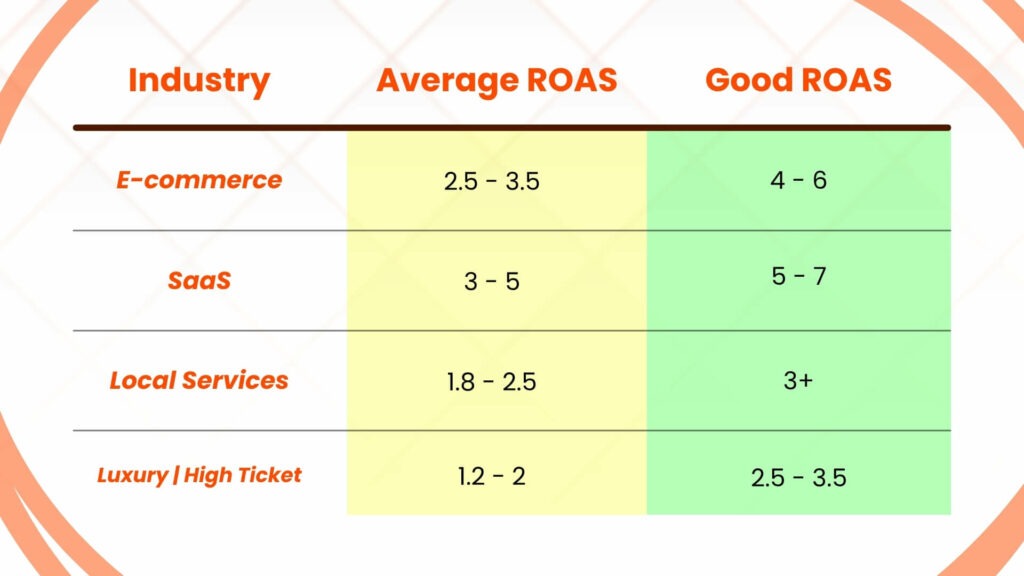
The real question isn’t “what ROAS should I target?” It’s “what ROAS do I need to be profitable?” And that math is different for every business.
What Factors Influence ROAS
ROAS is influenced by factors you control, factors you don’t, and factors most people completely ignore.
Your Industry Sets the Baseline
Some industries are just harder than others. Skincare and supplements can hit 6x+ ROAS because customers reorder monthly. Fashion brands struggle to hit 3x because everyone’s selling similar products and return rates are brutal.
B2B companies often panic about 2x ROAS until they realize their average customer is worth $50,000 over two years. Meanwhile, dropshippers celebrate 4x ROAS while making $3 profit per sale.
Understand this nuance before you go into any venture and you’ll save yourself some stress.
Your Margins Determine What’s Possible
This is where most people mess up the math. If your product costs $100 to make and you sell it for $120, you need 5x ROAS just to break even after ad spend. If you’re selling digital products with 90% margins, 1.5x ROAS might make you profitable.
Make sense? Always know your margins before you start running ads and establish that baseline.
Your Funnel Complexity Changes Everything
Sending cold traffic directly to a checkout page? Good luck getting more than 2-3x ROAS. Building a proper funnel with lead magnets, email sequences, and retargeting? Now you’re looking at 4-6x+ because you’re capturing people who weren’t ready to buy immediately.
Here’s what a smart funnel looks like:
Stage 1: The Hook: Your ad offers something valuable for free (guide, quiz, discount) to capture contact info. Maybe 15% of people who see your ad will take this step.
Stage 2: The Nurture: Email sequences educate, build trust, and address objections over 7-14 days. Now you’re not just another random ad in their feed.
Stage 3: The Retargeting: People who engaged but didn’t buy get hit with social proof, urgency, or better offers. These campaigns often have 5-10x higher conversion rates than cold traffic.
Stage 4: The Upsell: After someone buys, you immediately offer complementary products or upgrades while they’re in buying mode.
The math: Instead of converting 1-2% of cold traffic at $100 average order value, you might convert 8-12% of your email list at $150 AOV. Same ad spend, completely different results.
Most businesses stop at Stage 1 and wonder why their ROAS is low. The money is in the follow-up.
Platform Choice Matters More Than You Think
Not sure which platform to start on? It all depends on where your target audience hangs out. Here’s a quick rundown:
Facebook/Instagram: Perfect for introducing your product to people who didn’t know they needed it. You can target incredibly specific audiences, but you’re interrupting their social media time. Expect 2-4x ROAS on cold traffic, but 6-10x+ on retargeting campaigns. Creative quality makes or breaks everything here.
TikTok: Incredibly cheap traffic (sometimes $0.50-2 per click) but extremely creative-dependent. Your ad needs to look native to the platform or users will scroll past instantly. Creative fatigue happens fast. You might need new videos every 3-5 days. Great for testing offers quickly and cheaply.
YouTube: Longer-form content works better here, making it perfect for complex products or high-ticket services. People are in “learning mode,” so educational content performs well. Harder to scale but often produces higher-quality leads.
LinkedIn: Expensive clicks ($8-20+) but incredible for B2B targeting. Your $10,000 software package might get 2x ROAS on LinkedIn but would flop on TikTok.
Start where your audience actually hangs out, not where traffic is cheapest.
LTV Makes or Breaks Your Strategy
If you’re only measuring first-purchase ROAS, you’re missing the big picture. A customer who buys once for $50 might spend $500 over the next year through email marketing and repeat purchases.
But there is one place most businesses go wrong. They see a 2x ROAS on their initial campaign and think it’s barely profitable. But when you factor in repeat purchases, referrals, and upsells, that same customer acquisition cost might deliver 8-10x return over 12 months.
Example: A skincare brand spends $30 to acquire a customer who buys a $60 starter kit (2x ROAS). Looks mediocre, right? But here’s what happens next:
- Month 2: Customer reorders for $45 (email marketing, no ad cost)
- Month 4: Buys premium product bundle for $120 (retargeting campaign)
- Month 8: Refers a friend who also becomes a customer
- Month 12: Total customer value is $300+
Suddenly that $30 acquisition cost looks brilliant.
The problem? Most businesses don’t track beyond the first 30 days, so they optimize for short-term ROAS instead of long-term profitability. They cut campaigns that are actually building valuable customer relationships because the immediate numbers look weak.
To fix this, track your actual customer lifetime value by cohort. What does a customer acquired in January typically spend over 6 months? 12 months? Use those numbers to determine how much you can afford to spend on acquisition.
This is why subscription businesses can “lose” money on their first-purchase ROAS but dominate their markets long-term.
How to Improve Your ROAS in 2025
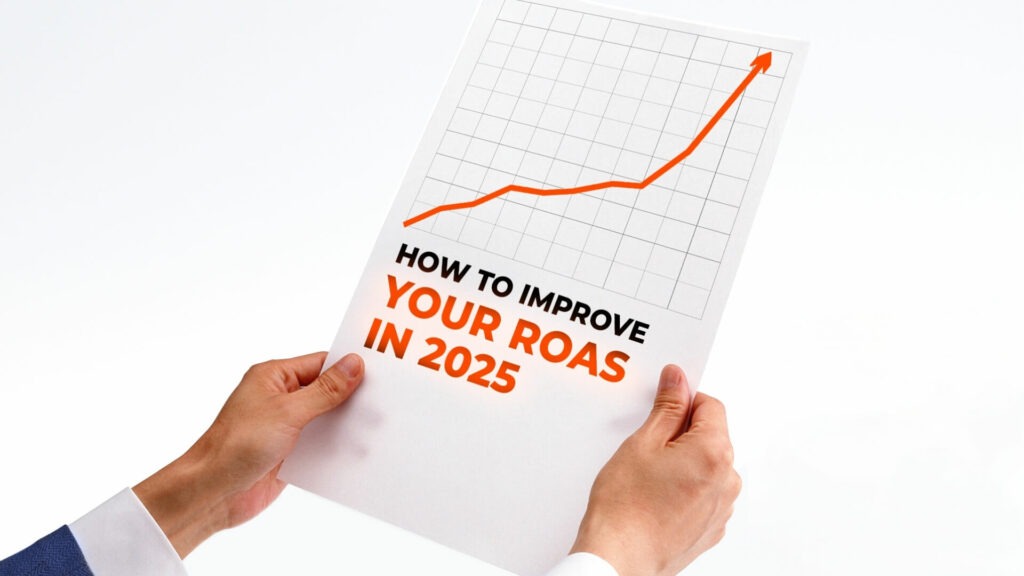
- Focus on Creative (Because Everything Else Is Meaningless Without It)
In 2025, your ad creative determines whether someone stops scrolling or ignores you completely. The best targeting in the world can’t save a boring ad.
What’s working now: User-generated content that looks native to the platform. People trust real customers more than polished product shots. Short-form videos (15-30 seconds) with hooks in the first 3 seconds. Test pain point angles (“Tired of…”) versus benefit angles (“Finally, a way to…”) because different audiences respond to different emotional triggers.
Pro tip: Create 5-10 creative variations for every campaign. Creative fatigue kills ROAS faster than bad targeting. What converts at 4x ROAS on day one might drop to 2x by day seven.
- Use First-Party Data (Your Secret Weapon)
With iOS updates and privacy changes, the businesses winning are the ones who own their customer data instead of relying on Facebook’s tracking.
Build your email list aggressively: Offer lead magnets, exit-intent popups, or first-purchase discounts in exchange for emails. Then use those email lists to create lookalike audiences that actually convert.
Segment everything: Don’t just retarget “website visitors.” Create separate audiences for people who viewed specific products, spent 2+ minutes on site, or added items to cart but didn’t purchase. Each segment needs different messaging.
Use your pixel data smartly: Upload customer lists to create custom audiences of your best buyers, then build lookalikes from those high-value segments, not just anyone who ever bought something.
- Optimize Landing Pages (Where Good Ads Go to Die)
A 5x ROAS ad campaign can become 2x ROAS if your landing page doesn’t convert. Most businesses focus 90% of their effort on ads and 10% on where people land.
Speed matters more than you think: If your page takes more than 3 seconds to load, you’ve lost 40% of mobile visitors before they see your offer. Use tools like GTmetrix to identify what’s slowing you down.
Mobile-first design is non-negotiable: 70%+ of ad traffic comes from mobile. If someone has to pinch and zoom to read your headline, you’ve already lost them.
Match your landing page to your ad: If your ad promises “50% off skincare bundles,” don’t send people to your homepage. Send them to a page specifically about discounted skincare bundles. Message matching can increase conversion rates by 30-50%.
- Retarget Smarter (Not Harder)
Most retargeting campaigns are lazy. “Retarget all website visitors” is like using a shotgun when you need a sniper rifle.
Segment by behavior intensity: Someone who viewed one product for 10 seconds is very different from someone who read reviews, compared options, and added items to cart. Create separate campaigns for each behavior level.
Time-based retargeting: Hit cart abandoners within 1-2 hours with urgency messaging, then switch to benefit-focused ads after 24 hours, then offer incentives after a week.
Cross-platform retargeting: Don’t just retarget on the same platform. Someone who engaged with your Facebook ad but didn’t convert might respond better to a Google display ad or YouTube video.
- Test Offers (The Fastest Way to Double ROAS)
Sometimes the difference between 2x and 5x ROAS isn’t your targeting or creative, it’s your offer structure.
Bundle products strategically: Instead of selling a $50 item, bundle it with a $20 accessory for $60. Higher order values often improve ROAS even if margins drop slightly.
Test different urgency tactics: Limited-time discounts work, but so do limited quantities, bonus items for early buyers, or free shipping thresholds.
Experiment with pricing psychology: $97 often converts better than $100, even though it’s only $3 different. Free shipping with higher product prices usually beats charging for shipping with lower prices.
When a Low ROAS is Still Okay (And Why That’s Actually Smart)
Most business owners think every single campaign needs to hit 4x+ ROAS or it’s a failure. That’s not quite right. In fact, that’s like expecting every player on a basketball team to score 30 points per game.
Different campaigns have different jobs.
Brand awareness campaigns might only hit 1-2x ROAS because you’re introducing your product to people who’ve never heard of you. But those “low performing” campaigns often set up your retargeting campaigns to crush it later. Someone needs to see your brand 3-7 times before they’re ready to buy.
Lead generation campaigns aren’t optimized for immediate sales, they’re optimized for collecting high-quality contact information. A campaign that generates emails at $5 each might look terrible at 1x ROAS, but if those emails convert to $200 lifetime value customers through your email sequences, you’re winning.
Top-of-funnel (TOF) campaigns warm up cold audiences and feed your retargeting pools. That Facebook campaign with 2x ROAS might be the reason your Google Search campaigns are performing so well, people saw your Facebook ad first, then searched for you later.
The key is measuring the ecosystem, not individual campaigns in isolation. Your brand awareness campaign might have low ROAS, but it makes all your other campaigns perform better.
Your Next Move: Think Strategy, Not Just Numbers
Obsessing over ROAS without understanding context is like judging a movie by one scene. The number matters, but the story behind it matters more.
Stop chasing the ROAS benchmarks you read in marketing blogs and start calculating what makes sense for your business.
Focus on building systems that compound over time such as better creative processes, smarter funnels, stronger email sequences, and actual customer relationships. These are what turn good ROAS into great businesses.
And if you’re feeling overwhelmed trying to optimize ROAS while running everything else in your business, that’s completely normal. Digital marketing is a full-time job, and doing it well while managing operations, customer service, and growth is genuinely difficult.
Which leads us to our final point…
If you’re ready to build a marketing strategy that drives profitable growth, the Digital Time Savers team helps businesses like yours optimize their ROAS through proven systems and strategies that fit your specific situation. We focus on building sustainable growth engines, not just chasing vanity metrics. So, if you’re in need of a team who wants to partner with you to succeed, reach out to us today.
We’ll help you achieve a higher ROAS and grow your business in a sustainable way.
FAQ
What is a good average ROAS for eCommerce in 2025?
Most eCommerce brands aim for 3x–4x ROAS, but it depends entirely on your profit margins. Calculate your break-even ROAS first: 1 ÷ your profit margin percentage.
Can I scale a campaign with only 2x ROAS?
It depends on your unit economics and customer lifetime value. If your margins are strong or customers buy repeatedly, 2x might work. Calculate your true profitability first.
Does ROAS include all costs?
No. ROAS only measures revenue divided by ad spend. It doesn’t include product costs, shipping, or overhead. You could have 5x ROAS and still lose money.
What platform gives the best ROAS?
There’s no universal answer. Google Search often delivers higher ROAS due to purchase intent, but Facebook excels at discovery. Test where your audience actually shops.
How do I track ROAS accurately in 2025?
Use Google Analytics 4 with UTM tracking, but expect 15-30% discrepancies due to iOS updates and privacy changes. Cross-reference platform data with actual revenue.

